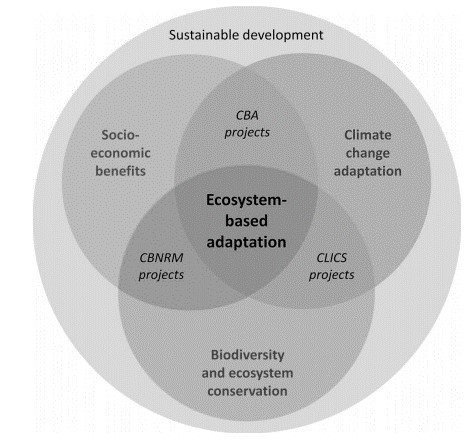Recommendations
- Effective EbA governance and management in local government requires appropriate regulatory and legislative frameworks. This should be supported by long-term planning, adequate resources and enabling tools, processes and systems.
- Effective institutional arrangements and partnerships, both within departments and across institutions, are required for coordination and collaboration. This will enable the strategic use of the limited resources available within various institutions.
- To obtain buy-in from practitioners, stakeholders and communities, the socio-economic benefits of EbA should be communicated through simple language and a clear message.
- Innovative sources of finance should be explored, supported by effective project packaging and marketing that explores and highlights the multi-faceted benefits of EbA.
Executive summary
Ecosystem-based adaptation (EbA) is the use of biodiversity and ecosystem services as part of an overall adaptation strategy to help people adapt to the adverse effects of climate change. EbA provides an approach to sustainable development that contributes simultaneously to socio-economic development, climate adaptation and biodiversity conservation. Owing to the multiple benefits of EbA, it can be of use to coastal cities and the multi-faceted systems that exist within these cities. This policy briefing highlights various barriers and challenges to the implementation and governance of EbA in South African coastal cities, with a particular focus on Cape Town and Durban.
Read the in-depth review: Ecosystem-based adaptation in South African coastal cities.
Introduction
EbA is often referred to as ‘natural solutions to climate change’.[1] According to the Convention on Biological Diversity, EbA is the use of biodiversity and ecosystem services [2] as part of an overall adaptation strategy. It includes the sustainable management, conservation and restoration of ecosystems to provide services that help people adapt to the adverse effects of climate change.[3] Drawing on the linkages between ecosystem services, climate change and biodiversity, EbA is an approach to sustainable development that contributes to three outcomes simultaneously: socio-economic benefits, climate change adaptation (risk and vulnerability reduction) and biodiversity conservation (see Figure 1). The Department of Environmental Affairs and the South African National Biodiversity Institute emphasise that EbA approaches must consider ways to manage ecosystems so that they can provide services that reduce the vulnerability and increase the resilience of socio-ecological systems to both climatic and non-climatic risks, while at the same time providing multiple benefits to society.[4]
In implementing EbA, there are many options for adapting to climate change in the coastal environment. These include ‘no-regret, low-regret or win-win interventions’ [5] that use biodiversity and ecosystem services as part of an overall adaptation strategy. However, EbA options are not mutually exclusive, and in certain cases a combination of approaches can be the most effective solution. EbA activities can take place alongside wider management efforts that address issues such as coastal land use patterns, environmental degradation, water management issues and conservation activities to improve ecosystem conditions.
Figure 1 EbA integrates biodiversity and ecosystem conservation, climate change adaptation and socio-economic benefits

Note: The intersection of two spheres means that the intervention is not EbA, but rather community-based adaptation (CBA), climate change integrated land use strategies (CLICS) or community-based natural resource management (CBNRM) interventions.
Source: DEA (Department of Environmental Affairs) & SANBI (South African National Biodiversity Institute), Strategic Framework and Overarching Implementation Plan for Ecosystem-Based Adaptation (EbA) in South Africa: 2016–2021. Pretoria: DEA, 2016
EbA in South African coastal cities
Durban and Cape Town are key economic zones and important contributors to the South African economy. These cities have sizeable populations living in informal housing (Cape Town, 25%; Durban, 20%) [6] and below the poverty line (Cape Town, 20%; Durban 30%).[7] They are also increasingly exposed to climate impacts such as flooding, rising sea levels, seawater intrusion and coastal storm surges. These climate impacts will affect not only urban economies but also the livelihoods and well-being of coastal populations.
There is, therefore, a strong case to be made for promoting EbA in South African coastal cities, since it enables climate adaptation and disaster risk reduction, while also providing services that can improve people’s livelihoods. However, various barriers and challenges exist in the implementation and governance of EbA. For South Africa to reap the benefits offered by EbA, it is crucial that the challenges are addressed, and that the opportunities related to these areas are maximised. The outcomes of this policy briefing provide learning opportunities for African and other developing coastal cities.
Regulation, governance and management
As a signatory to the Sustainable Development Goals (SDGs) and various multilateral environmental agreements, [8] South Africa is strongly committed to sustainable development. As such, sustainable development and sustainable resource governance is embedded in its national policies, legislation and regulations. Importantly, in terms of EbA, South Africa has developed the Strategic Framework and Overarching Implementation Plan for Ecosystem-based Adaptation in South Africa (2016–2021), supported by EbA guidelines, which promotes EbA as a central component of the country’s programme of work on biodiversity and climate change.
South Africa has three spheres of government – national, provincial and local – all operating at different scales. These are supported by various non-governmental organisations, civil society organisations, academic and research institutions. However, although the country has a rich institutional and regulative landscape, it experiences various challenges in the regulation, governance and management of EbA, particularly at the local level.
Local government requires relevant regulatory and legislative frameworks, supported by long-term planning and adequate resources, to enable effective governance and strategic direction. For instance, the lack of coastal management lines (CMLs) is inhibiting the implementation of EbA. CMLs for coastal municipalities and estuaries should be promulgated to ensure more integrated management of coastal areas and provide local governments with a stronger basis for managing and governing issues such as developments that encroach onto coastal ecosystems.
Added to this, there is not enough clarity on the jurisdiction between municipal, provincial and national government. It is essential that all stakeholders are informed about jurisdictions and relevant institutional arrangements, and that awareness is raised. Owing to these issues, coastal municipalities struggle to enforce legislation. Municipalities and other spheres of government need sufficient financial and human resources, as well as support from various partnerships. By sharing roles and responsibilities, different spheres of government will be able to implement their mandates more effectively.
Competing priorities, political objectives and strategic priorities in the context of limited budgets mean that choices need to be made regarding project selection, with EbA projects often side-lined in the process. It is recommended that champions are identified within municipalities to advocate for EbA. This can further bridge the knowledge and skills gap in those authorities responsible for EbA implementation and enforcement. Champions for EbA approaches can also ensure that guiding science and management frameworks are brought to the attention of local decision makers.
Lastly, a lack of long-term planning is a challenge at both the national and local level. Since conditions are fluid, long-term and multi-disciplinary planning should be integrated into decision-making processes. Added to this, local conditions must be taken into consideration by categorising high-risk areas/communities and climate impacts to ensure that these areas receive the necessary EbA focus. This will ensure a balance between the development and protection of ecosystems.
Institutional arrangements and partnerships
EbA has people at its centre, and uses participatory, culturally appropriate ways to address challenges.[9] Added to this, EbA is not a standalone practice, and, given that ecosystems generally do not have clearly defined borders, works best when various stakeholders collaborate.[10] Implementing EbA is therefore a social and institutional process that requires working together across sectors through partnerships with a clear focus on interventions that deliver co-benefits in an evolving context. This requires coordination at a number of levels in order to align partners’ resources and programmes of work towards the achievement of these benefits.[11]
Effective institutional arrangements and partnerships, both within departments and across institutions, enable coordination and collaboration and have proven useful in helping institutions meet their objectives. However, coordination challenges limit the ability of institutions to carry out their EbA mandate. For instance, different levels of government, and departments within these levels of government, tend to operate in silos, and as a result institutions do not collaborate as effectively as they could. Integration between various departments should be prioritised, as the delivery of a wide range of EbA benefits requires a coordinated programme of work implemented by partners and stakeholders across sectors. The establishment of local coastal committees is one way of promoting collaboration at this level.
Human resource and capacity constraints at all levels of government limit the functions that can be implemented. In such instances, partnerships make it possible to leverage greater implementation capacity than is possible when institutions act in isolation.
Partnerships provide opportunities for lesson sharing and knowledge exchange, and also facilitate alignment and more strategic allocation of limited resources.
Owing to limited participation by and unbalanced contributions from different stakeholders, partnerships often do not meet the required objectives and therefore can be unsustainable. It is essential that a shared purpose and vision is highlighted and understood by all. It is thus important to work in strong, collaborative partnerships, as cross-institutional partnerships create a sense of common purpose and build cohesion at a larger scale.
Knowledge, communication and engagement
Knowledge sharing, adaptive learning and communication are necessary to mobilise resources and enhance capacity for EbA. Communication and engagement should be done in a way that supports sustainability, knowledge sharing, replication and upscaling, and should also demonstrate that EbA is a valid and cost-effective adaptation option in the overall adaptation strategy. In addition, effective communication and equitable stakeholder engagement are necessary at all stages of the EbA intervention, as it is within these stakeholder networks that the requisite knowledge, experience, capacities and resources reside.[12]
The manner in which EbA is communicated plays a major role in determining whether relevant stakeholders support the initiative. It is essential that all stakeholders are included in the EbA conversation, and that simple language with a focused message relaying the socio-economic benefits of EbA is used. At the community level, lack of knowledge and ineffective engagement result in a lack of support for EbA projects. There is a need to explain simply and effectively the socio-economic benefits of EbA to communities by continuously engaging them. Within institutions, insufficient knowledge, coupled with ineffective communication, is one of the leading causes of unsuccessful collaborations and partnerships. More can be done to ensure that all practitioners understand climate change and how current and future climate impacts can and should be managed. Thisis particularly important since socio-economic factors that will be impacted by climate change are the responsibility of different departments.
To encourage knowledge sharing, peer learning and capacity development, improved communication should be promoted. This applies to both community members and practitioners in the municipality. Environmental awareness and education, driven by an in-depth understanding of the coastal risks and social drivers of negative environmental impacts, are essential in ensuring long-term behavioural changes. This can include: an annual lekgotla, forum or indaba, to provide a safe space for learning and knowledge- sharing for government officials and practitioners working with EbA; environmental education in primary or high school, to ensure that environmental protection becomes rooted in pupils’ everyday habits; and environmental literacy through citizen science programmes, to promote awareness of and support for nature-based adaptation options.
Financial mechanisms
Acting now on climate change can minimise negative impacts and costs in the long term. In the context of an uncertain future, finance and investment should focus on low-regret options that promote sustainable natural resource management and socio-economic development.[13] In most cases, EbA options are low-regret approaches that achieve multiple co-benefits and support the integrated delivery of SDGs. Unfortunately, public finance for EbA interventions, and for climate adaptation as a whole, is less than the amount required. It is thus necessary to learn how to tap into non-traditional sources of finance, including community contributions, [14] and to draw lessons from international EbA projects that have been financially supported through innovative national budgeting processes and public– private partnerships.[15]
Financial constraints compromise the ability of institutions to fund and implement EbA projects. Municipalities can get additional funding from both national and international sources. To improve their financial resources, they should explore innovative national and international approaches to climate finance, as this is key to ensuring that sufficient and sustainable funding is available to effectively implement EbA interventions. Innovative approaches include: implementing financing mechanisms based on partnerships
with different stakeholders; exploring payments for ecosystem services (PES) to enable EbA interventions; designing funds that ensure sustainable long-term project funding; implementing incentive schemes that encourage the uptake of EbA implementation, such as directly supporting coastal rehabilitation and conservation, or rewards for socially and ecologically sustainable practices; and going into partnership with the insurance industry, as it is well versed in evaluating coastal risks.
Added to this, municipalities should prioritise project packaging and marketing when seeking project finance, whether internally or externally. This will require projects to be designed using cross-sectoral teams that can highlight the multiple benefits, particularly socio-economic benefits, that are possible.
Conclusion
EbA provides multiple benefits for coastal cities and the populations they support. Despite a number of demonstrably successful EbA cases, current practice still focuses on planning and implementing ‘grey’ infrastructure solutions. It is critical that cities explore the multiple opportunities that exist for mainstreaming and implementation of EbA. This will not only improve coastal cities’ ability to adapt to climate change impacts but will also increase the resilience of coastal communities.
Footnotes
[1] DEA (Department of Environmental Affairs) & SANBI (South African National Biodiversity Institute), Ecosystem-Based Adaptation (EbA) Guidelines. Pretoria: DEA, 2018.
[2] Ecosystem services are the direct and indirect contributions of ecosystems to human well-being.
[3] CBD (Convention on Biological Biodiversity), ‘Climate change and biodiversity: Introduction’, https://www.cbd.int/climate/intro. shtml, accessed 20 September 2018.
[4] DEA & SANBI, op. cit.
[5] No-regret actions are cost effective now and under a range of future climate scenarios and do not involve hard trade-offs with other objectives. Low-regret actions are relatively low cost and provide relatively large benefits under predicted future climates. Win-win actions contribute to adaptation while also having other social, economic and environmental benefits. See climateXchange, ‘Examples of no-regret, low-regret and win-win adaptation actions’, https://www.climatexchange.org.uk/research/ projects/exam ples-of-no-regret-low-regret-and-win-win-adaptation-actions/, accessed 9 April 2019.
[6] SACN (South African Cities Network), State of South African Cities Report 2016. Johannesburg: SACN, 2016.
[7] Ibid.
[8] Including but not limited to the UN Framework Convention, Convention on Biological Diversity, UN Convention to Combat Desertification, Convention on Wetlands of International Importance and the New Urban Agenda.
[9] IIED (International Institute for Environment and Development), ‘Ecosystem-based approaches to climate change adaptation’, https://www.iied.org/ecosystem-based-approaches-climate-change-adaptation, accessed 10 December 2019.
[10] Chevallier R, ‘Promoting Marine and Coastal Ecosystem-based Adaptation’, Policy Insights, 56. Johannesburg: SAIIA (South African Institute for International Affairs), 2018.
[11] DEA & SANBI, op. cit.
[12] Jiménez Hernández A, Ecosystem-based Adaptation Handbook. Amsterdam: IUCN NL (International Union for Conservation of Nature – Netherlands), 2016.
[13] C40 Cities, The Future We Don’t Want: UCCRN Technical Report. New York: C40 Cities, 2018.
[14] Ibid.
[15] Chevallier R, op. cit.
Acknowledgement
SAIIA would like to acknowledge the valued contributions from eThekwini Municipality and the City of Cape Town, as well as the input and insights received from other stakeholders (ie. civil society, research institutions, public and private sector institutions). SAIIA is also extremely grateful to the German Embassy Pretoria, who have graciously provided funding for this research.







